Berlin and Leiden. Papers, Words and Music
Gastbeitrag von Dr. Anne Regourd
I. Introduction
For someone conducting research on the papers of Yemeni manuscripts, the collections at the Staatsbibliothek zu Berlin and at the University Library of Leiden complement each other in a way that is particularly fruitful for developing knowledge of the papers themselves and of the trade in papers.
Leiden is rich in items from the 19th and 20th centuries, among them a first-half century paper called “Abū Shubbāk”. In the Staatsbibliothek zu Berlin there are the 241 volumes of the Glaser collection. The collection was catalogued by Wilhelm Ahlwardt: Verzeichnis der arabischen Handschriften der königlischen Bibliothek zu Berlin, Berlin 1893. Its manuscripts range from possibly the 12th up to the 18th century, with a few items from the 19th century. This period of roughly seven centuries covers important changes in terms of paper production and trade. As a result, the Glaser collection testifies to the existence of a great variety of papers in terms of techniques of production, fabricants, countries/regions of production, and it is finally an exceptional tool to document the appearance and disappearance of a paper on the market, specifically in Yemen. All this information serves disciplines like History of the paper trade, Codicology and Philology. Many papers are still new in respect to our knowledge of the Yemeni market and need to be documented. The early category contains in itself various kinds of papers which remain unevenly studied and classified, whereas work is proceeding on late material, i.e. 17th to 20th century items. The first results of this enquiry will be published in the Proceedings of the International Conference “Shii Studies: The State of the Art”, held at the Institute for Advanced Study, Princeton (NJ, USA), 2017, December, 7-9.
Ms. Leiden Or. 6980: Text of records, Records of texts
Leiden University Library holds many items from Yemen of more or less recent acquisition. In particular, it possesses Or. 6980, a manuscript which is part of the personal library of the well-known orientalist Christiaan Snouck Hurgronje (now CSH). This manuscript is interesting in many ways, i.e. for its paper, the collection it is part of, and its text, which looks at first glance exceptional as it greatly improves our knowledge of live music at the very beginning of the 20th century, but also because it does not conform to the usual ‘stigmas’ of the manuscripts which, as copies or autographs, are part of the process of transmission of knowledge.
Moreover, and in an intangible dimension, it requires the lights of Ethnomusicology to understand circulation of styles and instruments, as well as the way the person whose hand has been at work managed his task. I would like to thank warmly Arnoud Vrolijk, University Library of Leiden, for his constant and kind help in excavating the context of this manuscript.
It was catalogued by Petrus Voorhoeve in his Handlist of Arabic manuscripts in the library of the University of Leiden and other collections in the Netherlands as follows: “Mugassas [correct to maǧass] and other songs, from Yemen and elsewhere, apparently written down for C. Snouck Hurgronje. 133 numbers” (P. Voorhoeve, Handlist of Arabic manuscripts in the library of the University of Leiden and other collections in the Netherlands, The Hague/Boston, University Press. of Leiden, 1957 [1st ed.], p. 426; J. J. Witkam (compiled by), Inventory of the Oriental manuscripts of the Library of the University of Leiden, vol. 7: Manuscripts Or. 6001-Or. 7000 registered in Leiden University Library in the period between May 1917 and 1946, Leiden, Ter Lugt Press, 2007, p. 356, on line)
II. Description of the ms. Leiden Or. 6980
The manuscript is made of 6 loose bifolios, i.e. not sewn together, 41 cm high by 57 cm wide, and all bifolios have been folded in two (with no pressure). The bifolios bear other marks of folding, which could indicate that they were rolled successively in two directions, then flattened, at an earlier stage.
Page numbers were originally attributed by the copyist from 1 to 22, which correspond to the pages with writing, then at a later stage by the library using a lead pencil, from 1 to 24, a comprehensive numbering which includes empty pages. As a result, page 1 for the copyist is page 2 for the librarian — the recto of the 1st folio having been left free by the copyist, and readers have two alternative page numbers on all pages bearing text. The copyist numbered the manuscript using the modern word “numra”.
All the text is written using black ink. The script is a careful one.
The manuscript contains pieces of sung poetry, which are also numbered, as in a list, from 1 to 133. Each piece is introduced by more or fewer musical notations such as musical instruments, music modes (maqam) and sometimes the name of the singer or muṭrib.
The text suddenly breaks off, without any end mark like a tatimma or an intiha’, at the second third of page 21, leaving the last third of the page as well as the two following pages (pp. 23-24 in the recent numbering) blank. In other words, it bears no colophon.

Fig.1. Ms. Leiden Or. 6980 – page 1. Courtesy Leiden University Library

Fig.2. Ms. Leiden Or. 6980 – page 21. Courtesy Leiden University Library
Several of the features described above, like the collection it belongs to, that of CSH, the loose bifolios and their various folding at different stages, a text in a shape of a list of numbered pieces of sung poetry, with no list-end mark, and the indication on music and singer make this manuscript a very unusual, and even a peculiar item. The questions it immediately raises concern:
- The circumstances in which the manuscript was produced, especially date, place and purpose;
- The kind of manuscript we have here.
III. The paper
The paper is a machine-made paper, Fourdrinier [Fig.1 and 2]. It is a yellow paper, which has become brown on its edges, and even browner on the “external” bifolios, where they are convex as a result of their folding in two.
The 6 bifolios were taken from 3 original sheets, of which the maximum dimensions (H x W), as reconstructed, are 57,5 cm by 81,5 to 82,6 cm.
It is a watermarked paper, with a single-rim shield containing a crescent with a human profile. The paper bears the name of its manufacturer, “Andrea Galvani”, and below is the place of its production, “Pordenone”, in cursive script. The other marks are that of the chain and laid lines. The laid lines are perpendicular to the script on all folios with no exception.
The height of the shield is 8 cm, with a maximum width of 5,8 cm. The maximal length of “Andrea Galvani” is 12,8 cm, and of “Pordenone”, 7,3 cm. The distance between the lower part of the letter ‘G’ of “Galvani” and the line basis of ‘n’ of “Pordenone” (straight below) is 5,1 cm. The distance between 2 chain lines is of 2,5 cm; 20 laid lines make 3 cm.

Fig.3. Ms. Leiden Or. 6980 – Watermark, Shield containing a crescent with a human profile. Courtesy Leiden University Library

Fig. 4. Ms. Leiden Or. 6980 – Countermark Andrea Galvani Pordenone.
Courtesy Leiden University Library
The 6 bifolios show they were cut with a sharp instrument on one side only. Hence the slight variation (ca. ± 1,1 cm) given above on the maximum width of the folios. This clear cut is located on the right of the name of the manufacturer. On each bifolio, we have either the information on the manufacturer or the watermark. In the exact order the bifolios were used to write down the list, the marks on them are alternately the following: bifolio 1/pp. 1-4, fabricant; bifolio 2/pp. 5-8, watermark; bifolio 3/pp. 9-12, fabricant; bifolio 4/pp. 13-16, watermark; bifolio 5/pp. 17-20, fabricant; bifolio 6/pp. 21-24, watermark. The “pairs” of bifolios, once pieced together correctly in order to reconstruct the original folio, are consistent, and we can approximately figure out the size of the offcuts: 0,7 cm (bifolio 1+2) ; 1,4 cm (bifolio 3+4), and 1 cm (bifolio 5+6). The corrected width of the original sheet is equal or superior to 83,5 cm.

Fig.5. Reconstruction of a paper sheet
Once reconstructed, the original sheet bears the information on the manufacturer in the left part, and the shield on the right; the human profile of the crescent in the shield faces in the opposite direction to the name of the fabricant.
Is this Galvani paper already known to us?
The arrangement of the marks in the original sheet changes from one Galvani paper to another, as does the direction of the crescent in relation to the name of the manufacturer. Other machine-made Galvani papers bear the same “text” about the fabricant in cursive script, sometimes with some differences in the written form. The shield however with its single rim is definitely ‘new’ to us in the Galvani papers recorded to date in Islamic manuscripts. The iconography of the crescent is also not comparable to the others. This is definitely an unrecorded paper.
What kind of information can be yielded from an unknown (to date) paper? Comparison of the history of the famous Galvani paper mills with the method of fabrication of this paper dates its production after the 1880s, the Galvani having delayed modernising their mills. Only at the very end of the 19th century did the factories of Pordenone and Cordenons begin to make a range of papers in a continuous process under the name of “Andrea Galvani / Pordenone”. Andrea (1797-1855) was, in this capacity, one of the most outstanding members of the Galvani paper-making dynasty. More a process than a project, the re-equipment was progressive: allowing for the period of modernisation, this paper cannot have been produced before the end of the 19th century or even the beginning of the 20th century. As for a terminus ad quem for the manufacture of this Galvani paper, it may extend to a period until 1960, the moment when the decision was made to stop using the name “Andrea Galvani” as a mark of the company. A detailed study of the paper was published in the Chroniques du manuscrit au Yémen 20 (July 2015), “Le manuscrit Leyde Or. 6980. 1re partie. Premiers éléments de datation et de localisation du manuscrit : apport d’un papier Andrea Galvani inédit”, pp. 65-81.
As a result, the study of the paper gives a terminus a quo for the production of the manuscript Or. 6980, i.e. the end of the 19th century, more probably the beginning of the 20th century, but still not a terminus ad quem for it, as the manuscript belonged to CSH’s collection. Moreover, whereas Andrea Galvani papers are a regularly traded item towards the Middle-East, Africa and the Arabian Peninsula, this Galvani paper remains unseen at lists in places where a manuscript production was still maintained in the first decades of the 20th century, even where extensive paper studies were conducted.
The pending questions of the terminus ad quem and the place of production of the manuscript bring us to the history of the collection and its owner.
IV. Christiaan Snouck Hurgronje (1857-1936) and the history of his collection
The piece under study belongs to the famous Arabist and Islamologist, informant of the Netherlands’ Government, then Advisor of the colonial government of the Netherlands for Indigenous, Arab and Islamic Affairs, Christiaan Snouck Hurgronje (1857-1936). Among his publications there are the two volumes named Mekka (Den Haag, 1888), reedited and translated (Chr. Snouck Hurgronje, Mekka in the latter part of the 19th century, London/Leiden, 1931), which are still a reference. Here, I will take into account only the information which is of interest for our enquiry.
We do not possess an inventory of Snouck’s collection. But the first immediate and positive datum for us is that his personal library, of which our manuscript is, indeed, part, entered the University Library of Leiden in 1936, the year when he died. And this gives us a kind of terminus ad quem for our manuscript: all put together, we have an item produced between the very beginning of the 20th century and 1936, in a rough evaluation, although not the worse for a late Islamic manuscript.
Now let us follow the hypothesis formulated by Voorhoeve, i.e. a text composed of songs “from Yemen and elsewhere”, which could have been written down for Snouck himself, or on his request. CSH is known for having ordered the copying of manuscripts or for having received manuscripts as gifts. Other manuscripts of poetry belonged to him, for instance Leiden mss. Or. 6981 and 6997 (qaṣā’id). Interestingly, Or. 6997 refers to numerous localities of the Hadhramawt, among others Tarīm, to Ṣanʿāʾ, as well as to Singapore and Batavia.
CSH sojourned in the Arabian Peninsula between August 1884 and, probably, September 1885. He settled in Jeddah, then in Mekka; he did not enter Yemen. But the paper of Or. 6980 already told us that the text could not have been written down before the end of the 19th century, more probably at the beginning of the 20th century. Snouck, then, from 1889 to 1906 settled in the Netherlands East Indies, today Indonesia, in Batavia/Djakarta, on the Island of Java. This period is definitely of interest to us. There he had direct and indirect contacts with Yemeni people (Hadhramawt). If we add the fact that the Galvani paper is new to us for the Arab world, a production of our manuscript at that time and place is an option, but still a hypothesis. Although the correspondence of Snouck is a very fruitful, still under-studied source, no indication is given by Voorhoeve to support his suggestion.
V. CSH collection of music records on wax cylinders and Poem no. 13
The CSH collection which reached the University Library of Leiden is known to include noticeable music records on wax cylinders realized by the Dutch Consulate in Jeddah between 1906 and 1909. According to a pre-evaluation, we are talking here about more than 300 records. At first glance, this does not correspond to our 133 entries. The collection of music records is under cataloguing by Anne van Oostrum, an ethno-musicologist from Amsterdam University — an immense work, which will take some time in respect for the quality of the sound and the condition of the cylinders. Eventually, the catalogue will be made freely available on the site of the University of Leiden, with access to the recordings. Anne van Oostrum published a first account of her work, especially on one of the songs, with cross-references to her field study in Jeddah, but also to the manuscript Leiden Or. 6980 (Anne van Oostrum, “Arabic music in Western ears: An account of the music of the Hejaz at the turn of the twentieth century”, Quaderni di Studi Arabi s.i. 7, pp. 127-144, 2012 ; id., “Music and Musicians of the Hejaz: An Account of the Dutch Arabist Christiaan Snouck Hurgronje (1857-1936)”, in: Jürgen Elsner, Gisa Jähnichen & Cenk Güray (eds.), Maqâm Traditions Between Theory and Contemporary Music Making, Joint Symposium of the ICTM Study Groups “MAQÂM” and “Music in the Arab World”, Ankara, Dec. 2014, Istanbul, Pan Publishing, pp. 195-212, 2016).
In other words, we have a record of at least one of our pieces (no. 13), and the contextual information about instrument and singer given in the manuscript corresponds with it.
Ms. Leiden Or. 6980 – Poem no. 13:
نمرة ثلاثه عشر طرب يمانى بالعود والمطرب سراج قرع والقصيده لخو علوى
يقول اخو علوى نونيا المسير * قم شد يا حادى الركاب
الى بعد مسراك عده قريب * بوبه واجب ? زيارت ا
س يون 87 من بقا يس تجير * ما مثلها فى كُ جانب
العشق يا ناس دوله وَمسير * ايضا وفى العشق مذاهب
من ل يحب الزين لو وسط بير * ول تعده قط صاحب
غيره
A first publication by Carney E.S. Gavin and Franz Lechleitner in the Phonographic Bulletin in 1985 insisted on the interest those recordings deserve, for their content and technically, as recordings on wax cylinders are in itself a momentum of the history of music records (C.E.S. Gavin, “The Earliest Arabian Recordings: discoveries and work ahead”, Phonographic Bulletin 43, pp. 38-44 ; F. Lechleitner. 1985. “The Arabian cylinders — report on the re-recording of the collection of the Oriental Institute in Leiden”, Phonographic Bulletin 43, pp. 44-45, 1985). More recently, Arnoud Vrolijk & Luitgard Mols put the finger again on the collection, out of technical interest, but also as the earliest sound recordings in the Arabian Peninsula known to date (L. Mols & A. Vrolijk, « Edison phonograph and wax cylinders, used for the earliest sound recordings in the Arabian Peninsula by Consul N. Scheltema and staff, Jeddah 1908–1909 », Western Arabia in the Leiden Collections , Leiden, Leiden University Press, 2016). And here we have all that has been published so far on the records on wax cylinders and on the manuscript Or. 6980.
To conclude this section, from the history and content of the collection we could get a better idea of the period of production of our manuscript, but, still, we have to go further into our enquiry to answer our question about the circumstances of the production and, above all, the kind of ‘manuscript’ we have here.
VI. The contribution of the text edition
The ca. 110 pages of the annotated text edition of ms. Or. 6980, together with the new comments brought to light by Jean Lambert and myself, are published in the second part of the monograph dedicated to the ms. Or. 6980: : “Le manuscrit Leyde Or. 6980. 2e partie. Poésies chantées dans le Ḥiǧāz au début du xxe s. : la transcription par un lettré de documents sonores. Édition du texte”, Chroniques du manuscrit au Yémen 24 (July 2017), pp. 113- 216. Multiple indices are annexed.
To fully understand scope and form of this manuscript of poems, it is first necessary to emphasize that they were put in writing by a person — whose identity we do not know — listening to the recordings made by the Dutch Consulate in Jeddah between 1906 and 1909. These texts result from a knowledge that is indissolubly both oral and written.
This gives substance to the assumption that these poems were transcribed at the request of CSH to document the music recordings he had commissioned. It can be inferred, then, that this person could be Muḥammad Saʿīd Tāǧ al-dīn, a Ḥiǧāzī resident in Jakarta, or even his brother, who resided in Ḥiǧāz, as, according to correspondence at the Museum of Ethnology in Leiden, these two brothers had collaborated with CSH during the recording of the musicians (according to Mahmūd ʿAbd al-Ġanī Ṣabbāġ, who relies on Leiden documentation, see his website: 2012/04/18/songs-of-the-hejaz). However, it cannot be ruled out that this documentation was prepared by another person after the recordings had been made. In any case, this explains the list form of the text and gives this manuscript its very special character: far from being a copied text intended for the transmission of knowledge, it is in fact an inventory.
The transcriber
From what we can see from the manuscript and from the context, the transcriber had to be a literate person who knew many of these texts, but who also often made mistakes on words that he did not identify well, except in cases where he has faithfully transcribed some of the mistakes of the singers themselves. This hypothesis could be verified by listening to a certain number of these recordings which, indeed, can induce such errors: they are favored by the abundance of dialectal linguistic features of several regions of Arabia, in view of the knowledge of classical Arabic by the transcriber. The transcriber is also mistaken about certain author attributions, but it is likely that he followed a local oral tradition that was not necessarily very literate.
However, the transcriber also appears to have an excellent knowledge of music of the Ḥiǧāz, since he frequently indicates melodic forms and modes, maǧass, including some forms that were not classified in the modal nomenclature in the practices of the Ḥiǧāz, for instance the maǧrūrs nos. 125, 126. He was, then, a musician — or at least a very knowledgeable listener, although we may likely suppose that he was helped by musicians.
The edition of this handwritten text thus combines the usual difficulties of publishing written texts with those encountered in the study of texts of oral tradition: here, the oral and the writing interpenetrate intimately. More than that, the annotated edition of the text reveals several levels of poetic texts: those of the known or published dīwāns, those of the manuscript and those of the recordings, thus giving access to several versions in circulation. From the point of view of the observation of scribal practices, and if we assume the hypothesis of transcription, the differences between the version of the manuscript and that of the recording would come from the fact that during the process of transcribing, the version that the transcriber has in memory takes precedence over the version he listens to or, better, hears. Some poems of classic poetry, not being vocalized, may seem dialectal; some words are transcribed dialectally, for example the pronunciation of ġarrid in ġarhid (poem no. 59); author attributions are often owing much to the imagination, and frequently involve local folk poets who remain poorly identified. In our text edition, we have attempted to account for this complex, but rich and highly interesting reality, entailing many methodological considerations. Now let us go deeper into the text.
Poetry, music and instruments
Poetry in classical Arabic is present in a relatively limited way. As in many other parts of the Arab world, the great poets sung are especially Ibn al-Fāriḍ and, to a lesser extent, Ibn al-Sahl al-Andalusī, Ṣafiyy al-dīn al-Ḥillī, Ibn Sīnā al-Mulk, al-Šarīf al-Raḍī, al-Naḥḥās, as well as lesser-known Syrians and Iraqis such as Ibn al-Wardī, Ibn Maʿtūq, Alūʾwaʾ al-Dimašqī, who are for the most part each represented by a single poem. We will therefore focus more on the dialectal poetry in a variety of forms, much more specific to the region.
A very large part of this poetry is Yemenite or of Yemeni origin, written in the ḥumaynī style. We should recall here that this style of literary poetry is strongly marked by the dialectal language and has been transcribed since at least the 13th century in manuscripts and collections, safīna and dīwāns. This poetry is distinguished by versification rules and very particular literary tropes. It developed in Yemen in the Middle Ages, assimilating Egyptian influences, especially the shape of muwaššaḥ combining three different types of stanzas in the same poem. It had a kind of golden age that can be dated between the 16th and the 18th century in the Ṣanʿāʾ area, with Muḥammad Šaraf al-dīn (poem no. 108 and note 352), ʿAbd al-Raḥmān al-Ānisī (nos. 93-96, mentioned, but not represented in our text), and Muḥsin ʿAbd al-Karīm (no. 61). At the same time, this style also developed greatly in the Ḥaḍramawt and, following the emigration of the Ḥadramīs, in South and Southeast Asia between the 18th and the 19th century, with poets like Yaḥyā ʿUmar, Ḫū ʿAlwī and ʿAbd al-Raḥmān Muṣṭafā al-ʿAydarūs, all three well represented in the corpus. Finally, we can distinguish a third branch of the ḥumaynī in Tihāma of Yemen, under the name of šille, whose history is not well known, but which develops much with Ǧābir Rizq (late 19th century), a poet abundantly represented in this corpus (nos. 58, 65, 111, 113, 119, 127).
However, many of these poems are anonymous or have authors who are not well identified beyond an often clearly Yemeni surname, for example, al-Ḥāšidī, al-Kawkabānī, al-ʿUdaynī, al-Zabīdī, al-Zaydī. Some poets of Ḥiǧāz are mentioned by their full name and are well identified, such as šayḫ Ibrāhīm al-Uskūbī al-Madanī (classical Arabic) and ʿAbd al-Wāḥid al-Ǧawharī al-Ašram (more colloquial Arabic). But we also note the presence of several poets from the Ḥiǧāz employing colloquial Arabic expressions who are not yet well identified: Bā Mašmūs, al-Sayyid Saḥra, Šihāb, Muḥammad Bāz, Ibn Ḫālid.
In this corpus there are also many pieces of popular poetry of the Ḥiǧāz of purely oral tradition, which are mostly anonymous and are sung especially with the accompaniment of percussion instruments: the maǧrūr, dāna, farʿī, ḥadrī, rakbī genres, wedding songs, especially the singing of women as they prepare the bride, tartīb, as well as songs of pilgrimage to the Prophet’s mosque in Medina. All these forms are strongly dialectal, but in styles that are noticeably different from ḥumaynī poetry. Some of them can be compared to the Nabāṭī poetry of Central Arabia. Because they are of purely oral tradition, they were little or not written down at all, and with this document, we have one of the first written records in hands. Associated with their sound recordings as well as their documentation thanks to the ethnographic information collected by CSH (1888), then by Hind Bā Ġaffār (1994), these texts thus make a considerable contribution to a distinct progress in our knowledge of the traditional society of Ḥiǧāz at the beginning of the 20th century.
The question of the influence of ḥumaynī poetry of Yemen on the poetry and music of Ḥiǧāz is therefore posed by this corpus of Jeddah/Leiden. In view of the above, it appears that this influence is considerable and relatively old. It is partly explained by the geographical and cultural continuity between Yemen’s Tihāma and Northern Tihāma (Ǧīzan, Jeddah). Three poets from Hadramawt of the 17th and 18th century have a significant quantitative presence in the corpus: Yaḥyā ʿUmar (poems nos. 15, 21), Ḫū ʿAlwī (nos. 11, 13) and ʿAbd al-Raḥmān al-ʿAydarūs (nos. 2, 90, 129). The influence of the Hadramawt is partly explained by the maritime trade that went from Egypt to India through the entire coast of the Arabian Peninsula. For the Ḥiǧāz, we must add the movement of pilgrims. Thus, we find a first poet of ḥumaynī, al-Baytī, who was born in Medina in the 17th century (poem no. 26), but originated from Hadramawt. And without a deeper study, it is still difficult to say how much local poets have been concretely influenced by these Yemeni poets.
Let us mention some more recent popular Syrian and Egyptian sung poems, notably dawr, which appear at the end of the list, and which, we should say, were already known in the Ḥiǧāz by this time, perhaps thanks to the first 78 rpm records which had begun to circulate from Egypt after 1904.
Musically, we note that these poems, mostly of Yemeni origin, are sung in very specific musical forms of the Ḥiǧāz: śargayn, the rawdamānī, the yamānī, perhaps of Yemeni origin, but imported to Ḥiǧāz in the distant past. The musicians mentioned, mainly Sarrāǧ Qurʿ, Sulaymān Metwallī, Muḥammad Dahlān and a certain Ḫiṭāb (or Ḫaṭṭāb), seem to be specifically ḥiǧāzīs, but do not seem to be known from other sources. Only one, Ḥasan Ǧāwā, is known to have cantillated at the Prophet’s mosque in Medina, and also for having recorded some secular songs on 78 rpm discs (see poem no. 32 and note 161).
Many of the texts are sung with the accompaniment of the four-string qabūs lute, which had already been mentioned by CSH (in: Mekka in the latter part of the 19th century, [1888] 1931, p. 45); however, in the manuscript, the term qabūs is never used. The instrument itself is mentioned only a few times as ʿūd (nos. 13, 14, 15, 17, 18), and once as “ʿūd Yemenite”; on the other hand, in the vocal announcements of the recordings, it seems to be designated as “(lute) to four (strings) of Ṣanʿāʾ” (arbaʿ ṣanʿānī), an expression which never occurs in the manuscript. If it turns out that the collection includes more than 300 recorded pieces, with about 130 with the accompaniment of “qabūs/gambūs”, this would be by far the largest and oldest recorded corpus of this instrument. Just for how long the “qabūs/gambūs” has been present in the Ḥiǧāz is a question that remains to be answered.
Frau Dr. Anne Regourd, ERC, Advanced Grant, „Islam in the Horn of Africa“, University of Copenhagen, war im Rahmen des Stipendienprogramms der Stiftung Preußischer Kulturbesitz im Jahr 2017 als Stipendiatin an der Staatsbibliothek zu Berlin. Forschungsprojekt: „Examination of „safīna“ volumes, and papers of Yemenite manuscripts, in the collections of the Staatsbibliothek zu Berlin“
Werkstattgespräch zu Ms. Leiden Or. 6980 am 25. 10. 2017

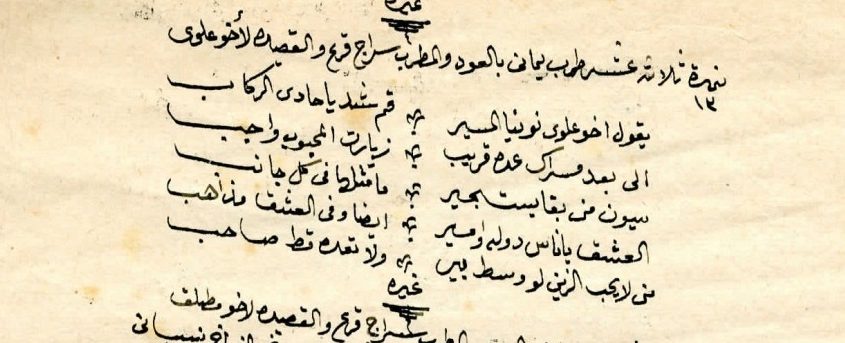
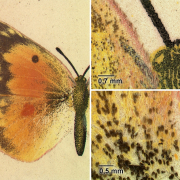

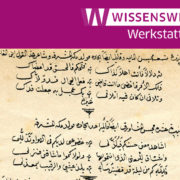 K:\IID\IID_2_Wissenschaftliche_Dienste\01_uebergreifendeAufgaben\Wissenswerkstatt\Werkstattgespraeche\2017\Arab.Handschriften\AW WG Arabistik.msg
K:\IID\IID_2_Wissenschaftliche_Dienste\01_uebergreifendeAufgaben\Wissenswerkstatt\Werkstattgespraeche\2017\Arab.Handschriften\AW WG Arabistik.msg
 CC-BY-NC-SA
CC-BY-NC-SA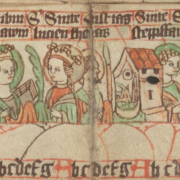 https://creativecommons.org/publicdomain/mark/1.0/deed.de
https://creativecommons.org/publicdomain/mark/1.0/deed.de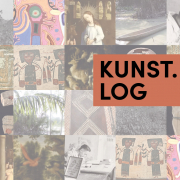
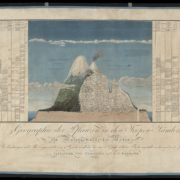


Ihr Kommentar
An Diskussion beteiligen?Hinterlassen Sie uns einen Kommentar!